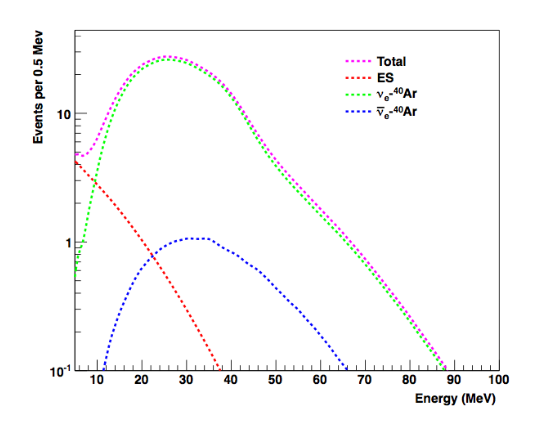Data Rates
Disclaimer
This page is under construction. It was originally developed for LBNE and is yet to be updated with more recent information contained in the CDR revisions and other documents.
Overview
According to the physics goals of the experiment, we need to consider the following main sources of signal:
- The "beam neutrino" signal
- The Supernova Burst (SNB) signal
- Proton Decay
- Solar neutrinos
All these signals have distinct energy scales, topologies and other characteristics. In terms of buffering and processing data in real or near time, they pose different requirements.
Beam Neutrinos
Because of the energy scale (~GeV range) neutrino interactions will be characterized by TPC signals well above radiological background. Zero-suppression will lead to significant reduction of data volume and rates (the detector will appear "empty" for the most part).
SNB
Reactions
νe+40Ar ⇒ e-+40K*
ν e+40Ar ⇒ e++40Cl*
νx+40Ar ⇒ νx+40Ar*
νe,x+e- ⇒ νe,x+e-
References
SNB
- DocDB 6977 - Software for low-energy signals
- DocDB 8481 - Summary of SNB Working Group Progress (February 2014)
Some reference curves from DocDB 6977:
In a nutshell:
- approximately 100 events per kiloton, spread over ~30 seconds, ~½ in first second
- all flavors, few tens of MeV
Other material
Proton Decay
References
- Very massive underground detectors for proton decay searches
- Nucleon Decay Searches with large Liquid Argon TPC Detectors at Shallow Depths: atmospheric neutrinos and cosmogenic backgrounds
- PDK at LBNF Meeting in Jan'15
Solar
References
- DocDB 6212 - M.Smy's slides from 2012 (LBNE solar studies potential)
Backgrounds
Background Sources
References
- DocDB 4482 - Craig Thorn's summary of Ar properties
- Measurement of the specific activity of Ar-39 in natural argon
Important radiologicals
- 39Ar 1.01 Bq/kg β- End-point: 0.565MeV
- 85Kr 0.1-0.3 Bq/kg β- End-point: 0.687MeV
Plots
Muon and Neutron Backgrounds (40Cl)
Summary Plots
Caveat - in the plots below the neutron data reflect the number of neutrons, not tracks, hits or counts created by neutrons. TBD!



